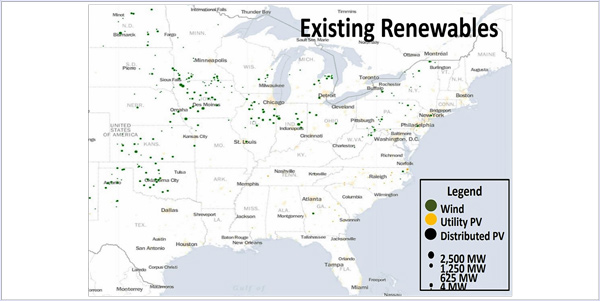By Amanda Durish Cook
MISO’s proposed multiyear evaluation on the future impact of integrating renewable energy will consist of 10 separate studies, with each focused on projected grid conditions at steadily increasing levels of renewable penetration.
But the RTO’s sweeping approach is drawing mixed reactions from stakeholders.
MISO policy studies engineer Jordan Bakke said the evaluation will first model current renewable penetration — about 8% of the resource mix. It will then examine growing system complexity in increments of 10% renewable resource penetration, concluding with an RTO system powered 100% by renewable sources.
At each 10% checkpoint, MISO will assess systemwide ramping capability, operating reserves, transmission congestion, voltage and frequency stability, and loss-of-load expectation, among other data.
“Between some milestones, the system complexity might not increase much, but at other points, it could increase a lot — and those are our inflection points,” Bakke said during a Sept. 27 Planning Advisory Committee meeting. “We currently don’t know where these inflection points lie.”
The evaluation will attempt to identify when the growth of renewables and the retirement of baseload units require changes in the structure or operation of the system, something MISO has not attempted to answer until now, Bakke said. (See MISO to Conduct Long-Term Renewable Integration Study.) It also aims to predict:
- How and when system reliability will be impacted by heavy renewable output;
- Whether there are limits to the amount of wind and solar generation MISO can support;
- How long until energy storage becomes a requirement;
- What parts of the grid will be stressed first; and
- How much renewable energy can be deployed before substantial system changes are needed.
The study will also explore what solutions will best mitigate system stressors, Bakke said, whether they be new transmission lines or buses, energy storage, better dispatch availability, demand response measures or better coordination efforts.
Bakke said he would return to later PAC meetings to discuss what MISO has discovered at each study milestone. The study doesn’t have a definitive end date, but Bakke said MISO would likely examine the effectiveness of continuing the study after a year.
Wind on the Wires’ Natalie McIntire said the study may not be “helpful or accurate” given that MISO has not yet reached a 10% renewable penetration and will take several years to achieve a 50%. Transmission could look very different by then, she noted.
“We’ve seen a lot come on in a relatively short amount of time,” countered Bakke, adding that MISO is especially interested in studying the system at a 30-60% renewable penetration, which may become a reality.
Other stakeholders pointed to the high number of renewable projects lined up in MISO’s interconnection queue, which could quadruple wind capacity in some parts of the footprint.
“We started out calling this a breakpoint study,” said MISO Director of Planning Jeff Webb. “If the systems breaks here, what do you do to fix it? And if it breaks here, what do you do to fix it?”
Some stakeholders said the study seems like a high-risk, low-reward endeavor, considering that advances in renewable technologies could solve their own shortcomings by then. Others suggested that generation and transmission owners might question the relevance of study results going out to 2050.
“We’re asking what things do we need to care about in 10 years, and what things do we have to care about in 30 years,” Bakke explained.
Xcel Energy’s Drew Siebenaler said that the study could yield a “holistic look” at renewables and system capability. “We fully support this effort as long as it takes,” he added.




